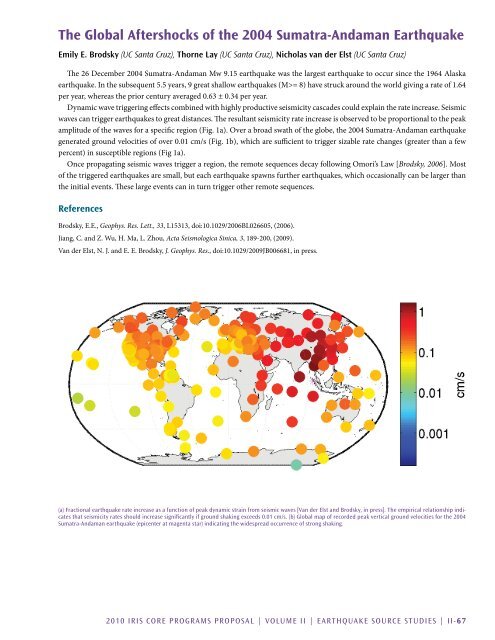Download Volume II Accomplisments (28 Mb pdf). - IRIS
Download Volume II Accomplisments (28 Mb pdf). - IRIS
Download Volume II Accomplisments (28 Mb pdf). - IRIS
You also want an ePaper? Increase the reach of your titles
YUMPU automatically turns print PDFs into web optimized ePapers that Google loves.
The Global Aftershocks of the 2004 Sumatra-Andaman Earthquake<br />
Emily E. Brodsky (UC Santa Cruz), Thorne Lay (UC Santa Cruz), Nicholas van der Elst (UC Santa Cruz)<br />
The 26 December 2004 Sumatra-Andaman Mw 9.15 earthquake was the largest earthquake to occur since the 1964 Alaska<br />
earthquake. In the subsequent 5.5 years, 9 great shallow earthquakes (M>= 8) have struck around the world giving a rate of 1.64<br />
per year, whereas the prior century averaged 0.63 ± 0.34 per year.<br />
Dynamic wave triggering effects combined with highly productive seismicity cascades could explain the rate increase. Seismic<br />
waves can trigger earthquakes to great distances. The resultant seismicity rate increase is observed to be proportional to the peak<br />
amplitude of the waves for a specific region (Fig. 1a). Over a broad swath of the globe, the 2004 Sumatra-Andaman earthquake<br />
generated ground velocities of over 0.01 cm/s (Fig. 1b), which are sufficient to trigger sizable rate changes (greater than a few<br />
percent) in susceptible regions (Fig 1a).<br />
Once propagating seismic waves trigger a region, the remote sequences decay following Omori’s Law [Brodsky, 2006]. Most<br />
of the triggered earthquakes are small, but each earthquake spawns further earthquakes, which occasionally can be larger than<br />
the initial events. These large events can in turn trigger other remote sequences.<br />
References<br />
Brodsky, E.E., Geophys. Res. Lett., 33, L15313, doi:10.1029/2006BL026605, (2006).<br />
Jiang, C. and Z. Wu, H. Ma, L. Zhou, Acta Seismologica Sinica, 3, 189-200, (2009).<br />
Van der Elst, N. J. and E. E. Brodsky, J. Geophys. Res., doi:10.1029/2009JB006681, in press.<br />
(a) Fractional earthquake rate increase as a function of peak dynamic strain from seismic waves [Van der Elst and Brodsky, in press]. The empirical relationship indicates<br />
that seismicity rates should increase significantly if ground shaking exceeds 0.01 cm/s. (b) Global map of recorded peak vertical ground velocities for the 2004<br />
Sumatra-Andaman earthquake (epicenter at magenta star) indicating the widespread occurrence of strong shaking.<br />
2010 <strong>IRIS</strong> Core Programs Proposal | <strong>Volume</strong> <strong>II</strong> | Earthquake Source Studies | <strong>II</strong>-67
















